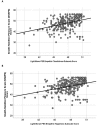The Measurement of Positive Valence Forms of Empathy and Their Relation to Anhedonia and Other Depressive Symptomatology
- PMID: 31031680
- PMCID: PMC6473075
- DOI: 10.3389/fpsyg.2019.00815
The Measurement of Positive Valence Forms of Empathy and Their Relation to Anhedonia and Other Depressive Symptomatology
Abstract
Construct validity of a brief self-report measure of "positive-valence empathy" (the tendency to exude positive emotion as a means to stimulate positive affect in others, and/or to vicariously share in another's positive emotion; Light et al., 2009) was attained utilizing a sample of 282 healthy adults. Positive-valence empathy may have unique predictive ability for differentiating depression versus depression with anhedonia. Confirmatory factor analyses revealed a two-factor structure for the final 15-item Light-Moran Positive Empathy Scale (PES), with an 8-item "Empathic Happiness" subscale (e.g., "I find that other people's happiness easily rubs off on me") and a 7-item "Empathic Cheerfulness" subscale (e.g., "I enjoy making others feel good"). "Empathic Happiness" was a significantly better predictor of overall depressive symptomatology (Beck et al., 1996) than anhedonia (Snaith et al., 1995). The Light-Moran PES-15 may have real-world impact and predictive utility for well-being.
Keywords: Beck Depression Inventory-II; anhedonia; empathic concern; hedonic capacity; positive-valence empathy.
Figures


Similar articles
-
Fronto-striatal activity predicts anhedonia and positive empathy subtypes.Brain Imaging Behav. 2019 Dec;13(6):1554-1565. doi: 10.1007/s11682-019-00081-z. Brain Imaging Behav. 2019. PMID: 30868401
-
Convergence and divergence of empathic concern and empathic happiness in early childhood: Evidence from young infants and children.Child Dev. 2025 Jan-Feb;96(1):341-354. doi: 10.1111/cdev.14176. Epub 2024 Sep 29. Child Dev. 2025. PMID: 39342634 Free PMC article.
-
Measuring change in anhedonia using the "Happy Faces" task pre- to post-repetitive transcranial magnetic stimulation (rTMS) treatment to left dorsolateral prefrontal cortex in Major Depressive Disorder (MDD): relation to empathic happiness.Transl Psychiatry. 2019 Sep 3;9(1):217. doi: 10.1038/s41398-019-0549-8. Transl Psychiatry. 2019. PMID: 31481688 Free PMC article. Clinical Trial.
-
Are we really measuring empathy? Proposal for a new measurement framework.Neurosci Biobehav Rev. 2017 Dec;83:132-139. doi: 10.1016/j.neubiorev.2017.10.009. Epub 2017 Oct 13. Neurosci Biobehav Rev. 2017. PMID: 29032087 Review.
-
Anhedonia and major depression: the role of agomelatine.Eur Neuropsychopharmacol. 2012;22 Suppl 3:S505-10. doi: 10.1016/j.euroneuro.2012.07.004. Eur Neuropsychopharmacol. 2012. PMID: 22959116 Review.
Cited by
-
Mapping Research Domain Criteria using a transdiagnostic mini-RDoC assessment in mental disorders: a confirmatory factor analysis.Eur Arch Psychiatry Clin Neurosci. 2023 Apr;273(3):527-539. doi: 10.1007/s00406-022-01440-6. Epub 2022 Jul 1. Eur Arch Psychiatry Clin Neurosci. 2023. PMID: 35778521 Free PMC article.
-
Susceptibility to positive versus negative emotional contagion: First evidence on their distinction using a balanced self-report measure.PLoS One. 2024 May 14;19(5):e0302890. doi: 10.1371/journal.pone.0302890. eCollection 2024. PLoS One. 2024. PMID: 38743712 Free PMC article.
-
Association Between Children's Empathy and Depression: The Moderating Role of Social Preference.Child Psychiatry Hum Dev. 2023 Jun;54(3):857-869. doi: 10.1007/s10578-021-01312-5. Epub 2022 Jan 4. Child Psychiatry Hum Dev. 2023. PMID: 34982305
References
-
- American Psychiatric Association [APA] (2013). DSM-V. Arlington, VA: American Psychiatric Association.
-
- Beck A. T., Steer R. A., Brown G. K. (1996). Manual for Beck Depression Inventory-II. San Antonio, TX: Psychological Corporation.
Grants and funding
LinkOut - more resources
Full Text Sources

